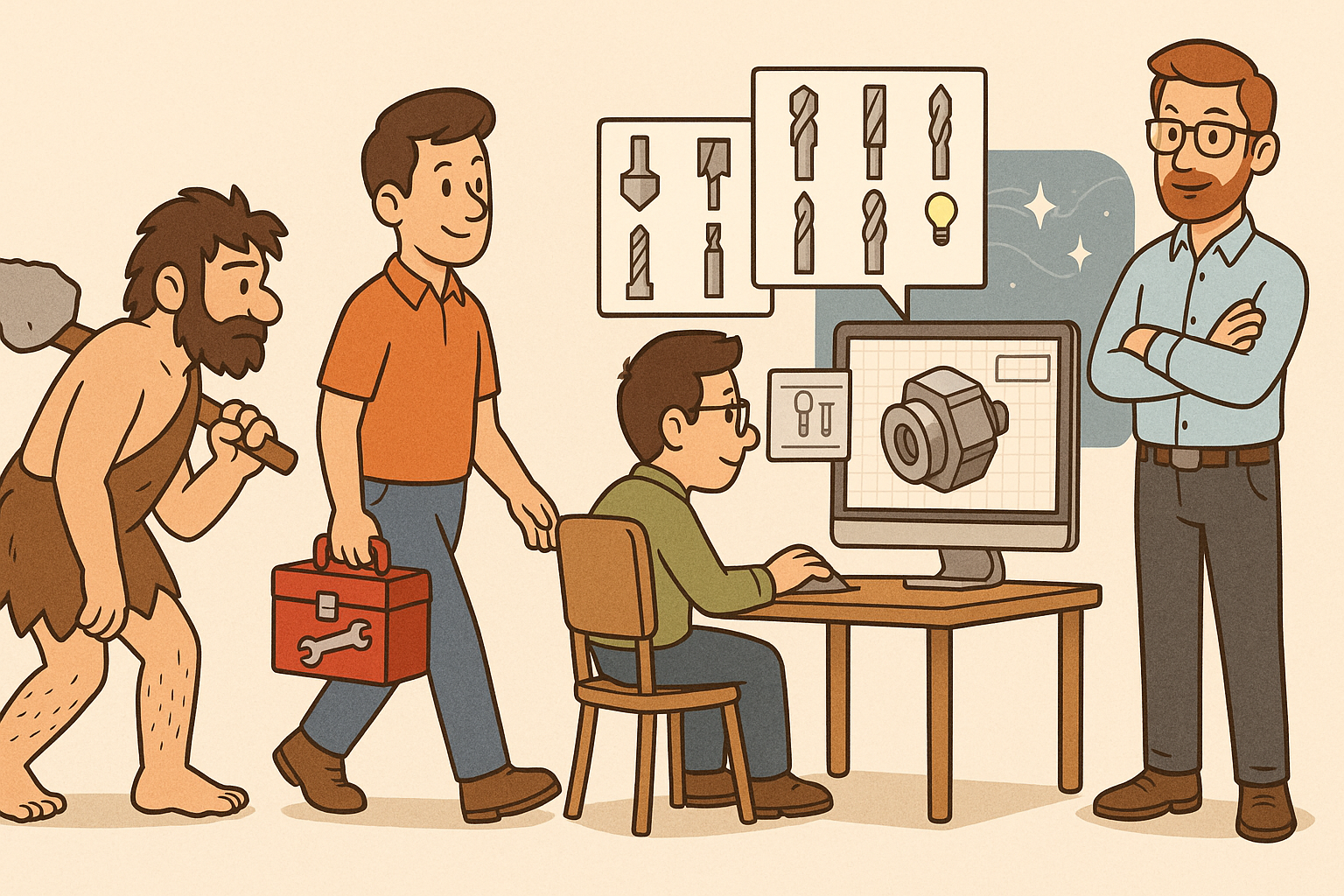Your Cart is Empty
Customer Testimonials
-
"Great customer service. The folks at Novedge were super helpful in navigating a somewhat complicated order including software upgrades and serial numbers in various stages of inactivity. They were friendly and helpful throughout the process.."
Ruben Ruckmark
"Quick & very helpful. We have been using Novedge for years and are very happy with their quick service when we need to make a purchase and excellent support resolving any issues."
Will Woodson
"Scott is the best. He reminds me about subscriptions dates, guides me in the correct direction for updates. He always responds promptly to me. He is literally the reason I continue to work with Novedge and will do so in the future."
Edward Mchugh
"Calvin Lok is “the man”. After my purchase of Sketchup 2021, he called me and provided step-by-step instructions to ease me through difficulties I was having with the setup of my new software."
Mike Borzage
Design Software History: The Evolution of Tool Libraries in CAD: From Basic Repositories to Intelligent Design Solutions
June 25, 2025 9 min read


Introduction and Foundations
The concept of tool libraries in computer-aided design (CAD) systems has played a pivotal role in shaping modern design processes. Envisioned as centralized repositories of reusable components, commands, and definitions, these libraries enabled designers to work more efficiently and achieve higher degrees of consistency in their outputs. In its earliest form, CAD software was often limited by the available computational resources and interface capabilities. As such, early design software practices necessitated the development of handy, repeatable sets of tools to manage complexities in drafting, geometric modeling, and engineering computations. This period of innovation laid the groundwork for reusable tool sets that were integrated directly into CAD interfaces, allowing for standardized design and accelerated workflows.
Emergence of Reusable Design Components
During the formative years of CAD, industry pioneers and academic researchers began to understand the potential of creating reusable tool sets that could be shared across various projects. The introduction of tool libraries marked a turning point as designers quickly realized that rather than recreating geometric elements and design parameters every time a project commenced, a storehouse of design components could provide consistency and speed. Notable early realizations emerged from groundbreaking work at institutions and companies such as MIT and early CAD firms, where research into computer graphics and user interface innovation helped form the blueprint for modern tools. The early tool libraries combined simple macros with more complex modeling commands, forming one of the earliest instances of a modular design approach.
Key Terminology and Foundational Concepts
Several core ideas remain central to understanding tool libraries in the CAD context. These include the adoption of standard design principles aimed at ensuring consistency, reusability, and a streamlined workflow. Designers often relied on terms such as parametric modeling, feature-based design, and modularity to describe their work. Fundamental concepts included the breakdown of complex design tasks into smaller, manageable subtasks, each managed by specialized tools curated in the library. These libraries functioned similarly to modern software frameworks and platforms, providing both the building blocks for advanced design processes and the context in which efficiency in engineering computations was nurtured. Additionally, several influential companies and academic figures stepped forward to formalize these practices through published work and new software innovations, establishing a shared lexicon that persists across the industry.
Influential Contributions in the Early Days
The interplay between academic research and commercial ventures helped propel CAD tool libraries from a rudimentary concept to a sophisticated technology. Companies like Autodesk were instrumental in establishing standardized tool sets that adapted to evolving CAD software. In tandem, academic research provided theoretical backing and practical experiments that validated the use of tool libraries in real-world design environments. Researchers and industry professionals introduced new methodologies that emphasized efficiency, consistency, and the avoidance of redundant design efforts. Throughout this period, several bullet points captured key milestones:
- Standardization: Efforts were made to standardize design operations to ensure that methodologies could be shared and reproduced.
- Modularity: The ability to take components such as geometric shapes and design macros and reuse them enhanced productivity.
- Scalability: As CAD systems advanced, tool libraries adapted, allowing for an expansion in both feature count and inter-operability.
Historical Milestones in Tool Library Evolution
The evolution of tool libraries has been marked by significant milestones that not only influenced the technology behind CAD systems but also shaped the workflows adopted by countless designers. Early breakthroughs in tool libraries were driven by the need to overcome the limitations of early computer hardware while addressing ever-increasing user demands for precision. As CAD software advanced throughout the 1970s and 1980s, pivotal developments emerged that broadened the scope of these libraries from merely storing drawing components to integrating complex algorithms for solid modeling and geometric computations. This was made possible as impactful software suites began to incorporate options for customization, thereby facilitating the transition from basic tool collections to more integrated and intelligent libraries that actively assisted in design decision-making processes.
Breakthroughs in the Advent of CAD
In the early days of CAD, tool libraries were essentially basic repositories where simple geometric shapes and pre-programmed commands were stored for repeat use. As companies like Autodesk began to make breakthroughs with products such as AutoCAD, the role of these tool libraries expanded drastically. Their evolution can be characterized by several key phases:
- Basic Repositories: Initial CAD systems stored simple, static tools to assist in repetitive design tasks.
- Integration of Algorithms: With growing computational capacity, CAD tool libraries began incorporating algorithms for parametric and feature-based design.
- Customization Capabilities: Increased user demand led to the development of user-friendly interfaces and customization options that allowed designers to tailor tool libraries to specific project needs.
Influence of Leading CAD Companies
Industry pioneers such as Autodesk and Dassault Systèmes have been at the forefront of advancing tool library functionalities. Autodesk’s integration of dynamic tool libraries within its later versions of AutoCAD serves as a testament to the company's role in transforming CAD workflows. In parallel, Dassault Systèmes, with its flagship software CATIA, redefined how tool libraries could be utilized for complex assembly designs and product visualization. Their contributions not only increased efficiency by streamlining design procedures but also fostered a more interactive user interface that allowed for further customization. Bullet points summarizing key influences include:
- Enhanced Customization: Companies implemented ways for end-users to modify and expand the available tool sets.
- Smart Algorithms: Integration of intelligent algorithms allowed for error checking and process automation.
- Feature Integration: Development of comprehensive libraries that incorporated simulation, analysis, and visualization features within a single platform.
Academic Contributions and Technological Advancements
Academic institutions and research initiatives also played a critical role in transforming tool libraries into essential components for modern CAD systems. Theoretical models developed at universities facilitated breakthroughs in geometric and solid modeling mathematics, while collaborative projects led by research groups further expanded tool library functionalities. Influential papers and conferences presented ideas that eventually became industry standards. Researchers introduced concepts such as:
- Parametric Design: Allowing tool libraries to dynamically adjust designs based on defined parameters.
- Algorithmic Efficiency: Advances in computational mathematics that improved the speed and accuracy of design tools.
- Data Interoperability: Techniques to ensure smooth data exchange between disparate design systems and tool libraries.
Impact on Design Processes and Software Innovation
The evolution of tool libraries had far-reaching effects on design processes and catalyzed substantial improvements in CAD software innovation. With integrated tool libraries, engineers and designers were empowered to work faster and more accurately than ever before, as the libraries provided reliable, standardized elements for design consistency and interoperability. The advent of these libraries ushered in a new era of computer-aided design, where the focus shifted from manually repeating similar design steps to leveraging dynamic, customizable tools that could respond intelligently to changing project requirements. As CAD systems became increasingly complex, tool libraries facilitated modular design processes that could be updated seamlessly, fostering a culture of continuous innovation in both hardware and software application development.
Revolutionizing Efficiency in CAD Workflows
One of the most prominent impacts of tool libraries was the enhancement of workflow efficiency in the design process. Prior to their widespread adoption, designers often had to recreate patterns and repeat operations manually, a process that was both time-consuming and prone to error. With the integration of smart tool libraries, a framework materialized where repetitive tasks could be automated or at least treated as a standard operation. This shift not only saved considerable time but also allowed designers to concentrate on the creative and analytical aspects of their projects. Features such as:
- Automation of Repetitive Tasks: Automated processes reduced human error and improved design consistency.
- Accurate Design Reproduction: Consistency ensured that every design iteration met strict quality standards.
- User-Centric Interfaces: Customizable tool palettes streamlined operations and reduced the learning curve for new users.
Influence on User Interface and Customization
As tool libraries matured, they began to directly influence the design of CAD software user interfaces. Early interfaces were often static and required users to interact with a minimal set of commands. However, with the incorporation of robust tool libraries, the emphasis shifted to customizable environments where users could adapt the interface based on their own workflows. This change was revolutionary because it empowered engineers and designers by providing them with the flexibility to tailor their digital workspace. Critical highlights include:
- Adaptive Tool Palettes: Direct manipulation of tool sets allowed quicker access to frequently used functions.
- Custom Script Integration: The ability to integrate custom scripts and macros further enhanced functionality.
- Enhanced Visual Feedback: Better visualization of tool interactions improved error recovery and overall design quality.
Current Trends and Future Innovations
Today, the legacy of early tool library innovations continues to influence design software development, with current trends reflecting an increased emphasis on cloud computing, machine learning, and collaboration. Modern CAD tools are now leveraging these historical insights to create even more robust, adaptive, and intelligent tool libraries. Built-in analytics and predictive algorithms, for instance, help anticipate design challenges and propose solutions in real time. The drive for enhanced interoperability between software systems and the need for faster prototyping have further spurred the evolution of tool libraries into dynamic, integrated systems that support a variety of design domains – from architectural modeling to industrial product design. As designers look forward to the next generation of CAD tools, key considerations for future innovations include:
- Integration with AI: Machine learning algorithms that dynamically optimize tool usage based on historical data.
- Expansion of Modular Design Principles: Further modularization will allow even finer control over design iterations.
- Cross-Platform Compatibility: Ensuring that tool libraries function seamlessly across various hardware and software ecosystems.
Conclusion
The historical journey of tool libraries in CAD systems offers a fascinating insight into how sustained collaboration between engineers, software developers, and academic researchers can lead to transformative innovations. Over the decades, what began as a simple repository of reusable design components has evolved into a sophisticated, integrated family of tools that significantly enhances workflow efficiency, accuracy, and productivity. The foundational contributions of early pioneers and the sustained commitment to innovation by leading companies such as Autodesk and Dassault Systèmes have left an indelible mark on the landscape of design software. Through revolutionary developments in user interface design, computational algorithms, and dynamic customization, tool libraries have reshaped not only the way designs are created but also how they are visualized and iterated.
Synthesizing Historical Contributions
Reflecting on the historical evolution of tool libraries, it is clear that the interplay of innovative concepts and practical engineering efforts has been crucial. Initially devised as simple repositories, tool libraries have blossomed into powerful components that drive modern design workflows. Key contributions have included:
- Standardization and Reproducibility: Early tool libraries set the stage for consistent and reliable design practices.
- Modularity and Customization: The ability to adapt the tools to meet specific user needs has empowered countless designers.
- Advanced Algorithm Integration: The inclusion of sophisticated mathematical models improved both speed and accuracy in design computations.
Outlook for Future CAD Advancements
In summary, the evolution of tool libraries from their rudimentary origins to the cutting-edge solutions we witness today exemplifies the power of interdisciplinary collaboration and iterative innovation. As we look to the future, the lessons learned from past breakthroughs, such as the importance of standardized, modular design practices, the enhancement of user-interface customization, and the integration of smart algorithmic processes, continue to be more relevant than ever. With emerging trends like artificial intelligence integration, enhanced cross-platform interoperability, and real-time collaborative design environments, the CAD ecosystem is poised to embark on new journeys of exploration and discovery. These ongoing advancements will undoubtedly yield tools that are not only more efficient and powerful but also more intuitive, paving the way for continued excellence in design, simulation, and engineering computation.
Also in Design News

Cinema 4D Tip: Tiered Cinema 4D Render Presets with Tokenized Outputs
December 16, 2025 2 min read
Read More
Revit Tip: Duct Routing Best Practices and Fabrication Workflow
December 16, 2025 2 min read
Read More
ZBrush Tip: GPU-Optimized ZBrush and Redshift Workflow for High-Poly Scenes
December 16, 2025 2 min read
Read MoreSubscribe
Sign up to get the latest on sales, new releases and more …


